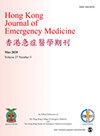Evaluation of the utilization of extracorporeal toxin removal in lithium poisoning patients in Hong Kong
IF 0.8
4区 医学
Q4 EMERGENCY MEDICINE
引用次数: 0
Abstract
Background: Extracorporeal toxin removal is used for enhanced elimination in severe lithium poisoning. The Extracorporeal TReatments In Poisoning workgroup provides recommendations on the use of extracorporeal toxin removal in poisoning. Objectives: Our aim was to identify the pattern for using extracorporeal toxin removal in managing lithium poisoning in Hong Kong and compare the outcomes in extracorporeal toxin removal-treated patients and non-extracorporeal toxin removal-treated patients if indicated for treatment as defined by The Extracorporeal TReatments In Poisoning criteria. Methods: Lithium poisoning presented between year 2009 and 2019 in Hong Kong Poison Information Centre (HKPIC) database was categorized into extracorporeal toxin removal-treated group and non-extracorporeal toxin removal-treated group. Comparative analyses were performed. Results: Among 112 lithium-poisoned patients, 21% were treated with extracorporeal toxin removal. Larger proportion of patients had fulfilled at least one Extracorporeal TReatments In Poisoning criteria for extracorporeal toxin removal in the extracorporeal toxin removal-treated group (87% vs 18%, p < 0.005). The extracorporeal toxin removal-treat group patients were more commonly presented with impaired consciousness, seizure and dysrhythmia (p < 0.05). They also got higher admission (3.62 mmol/L vs 2.18 mmol/L, p < 0.05) and peak (4.15 mmol/L vs 2.28 mmol/L, p < 0.05) serum lithium concentrations, as well as a significantly higher serum creatinine concentration upon presentation (263.74 µmol/L vs 98.66 µmol/L, p < 0.05). Extracorporeal toxin removal-treat group patients more frequently had a severe poisoning outcome (91.3% vs 9%, p < 0.05) and developed complications (69.6% vs 13.5%, p < 0.05). Logistic regression identified seizure, peak serum lithium concentration, and serum creatinine concentration upon presentation as risk factors for severe poisoning outcome. In subgroup analysis on patients with at least one indication for extracorporeal toxin removal as defined by Extracorporeal TReatments In Poisoning criteria, the proportion of severe poisoning remained higher in the extracorporeal toxin removal-treated group (90% vs 43.7%, p < 0.05). Complication rate was not significantly different between the two groups. Conclusion: Clinically severe lithium poisoning patients were treated with extracorporeal toxin removal in Hong Kong. Extracorporeal TReatments In Poisoning criteria can serve as a reference in considering extracorporeal toxin removal treatment for lithium poisoning patients. Nevertheless, Extracorporeal TReatments In Poisoning criteria recommend more extracorporeal toxin removal treatment than it was actually done. Lithium poisoning patients with positive Extracorporeal TReatments In Poisoning criteria have been managed without extracorporeal toxin removal. No statistically significant adverse outcome was observed in these cases.香港锂中毒患者体外毒素清除的应用评价
背景:体外毒素脱除法用于重度锂中毒的强化清除。中毒的体外治疗工作组提供关于使用体外毒素去除中毒的建议。目的:我们的目的是确定在香港使用体外毒素去除治疗锂中毒的模式,并比较体外毒素去除治疗的患者和非体外毒素去除治疗的患者的结果,如果根据中毒的体外治疗标准进行治疗。方法:将2009年至2019年香港毒物信息中心(HKPIC)数据库中出现的锂中毒病例分为体外除毒组和非体外除毒组。进行了比较分析。结果:112例锂中毒患者中,21%采用体外毒素脱毒治疗。在体外毒素去除治疗组中,达到至少一项体外毒素去除中毒标准的患者比例更大(87% vs 18%, p < 0.005)。体外毒素去除组患者出现意识障碍、癫痫发作和心律失常的发生率更高(p < 0.05)。患者入院时血清锂离子浓度较高(3.62 mmol/L vs 2.18 mmol/L, p < 0.05),峰值时血清锂离子浓度较高(4.15 mmol/L vs 2.28 mmol/L, p < 0.05),入院时血清肌酐浓度较高(263.74µmol/L vs 98.66µmol/L, p < 0.05)。体外毒素去除组患者出现严重中毒结局(91.3%比9%,p < 0.05)和并发症发生率(69.6%比13.5%,p < 0.05)较高。Logistic回归确定癫痫发作、峰值血清锂浓度和血清肌酐浓度是严重中毒结果的危险因素。在中毒标准中至少有一种体外毒素去除指征的患者的亚组分析中,体外毒素去除治疗组的严重中毒比例仍然更高(90% vs 43.7%, p < 0.05)。两组间并发症发生率无明显差异。结论:香港临床重症锂中毒患者采用体外毒素去除法治疗。中毒时的体外治疗标准可作为锂中毒患者考虑体外除毒治疗的参考依据。尽管如此,中毒的体外治疗标准推荐的体外毒素去除治疗比实际做的更多。在中毒标准中,体外治疗阳性的锂中毒患者不进行体外毒素清除。在这些病例中没有观察到统计学上显著的不良结果。
本文章由计算机程序翻译,如有差异,请以英文原文为准。
求助全文
约1分钟内获得全文
求助全文
来源期刊

Hong Kong Journal of Emergency Medicine
EMERGENCY MEDICINE-
CiteScore
1.50
自引率
16.70%
发文量
26
审稿时长
6-12 weeks
期刊介绍:
The Hong Kong Journal of Emergency Medicine is a peer-reviewed, open access journal which focusses on all aspects of clinical practice and emergency medicine research in the hospital and pre-hospital setting.
 求助内容:
求助内容: 应助结果提醒方式:
应助结果提醒方式:


